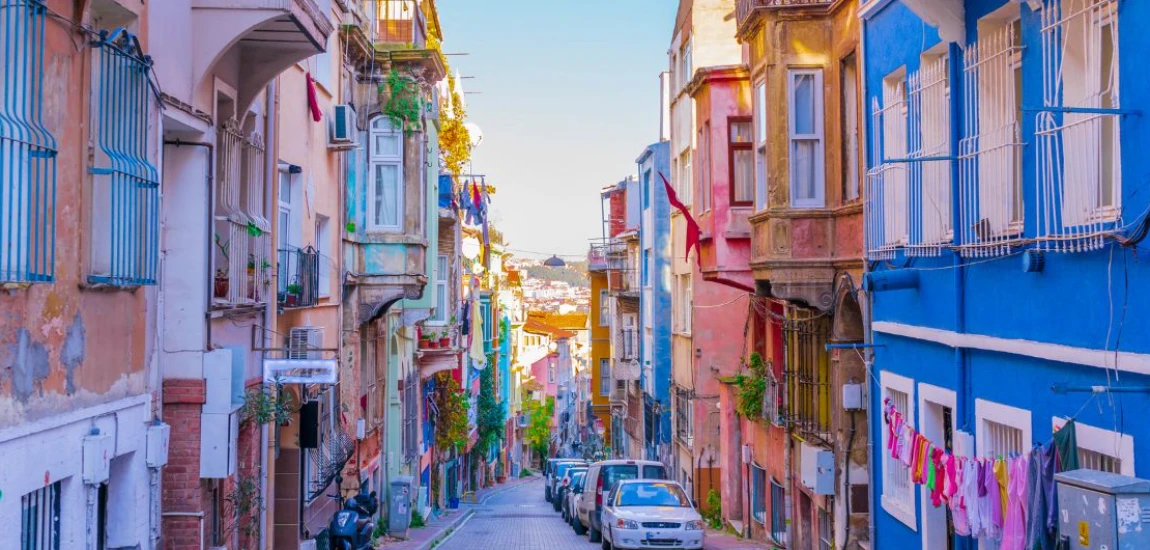Towns Where Every Building Is Painted the Same Color

Most towns are a blend of colors, from pastel storefronts to earthy brick homes. Yet, scattered across the world, there are extraordinary places where every building is painted the same color. These “monochrome towns” stand apart because they transform entire landscapes into immersive works of art. Travelers stepping into them often feel as if they’ve wandered into a painting, where the streets, squares, and rooftops form one cohesive masterpiece.
The reasons behind this practice are as fascinating as the effect itself. In some places, the choice of color is deeply tied to climate control—lighter shades like blue and white help reflect heat, making homes cooler in hot environments. Elsewhere, the decision is rooted in culture, religion, or symbolism: pink to welcome guests, red to reflect desert tones, or blue to signify spirituality. Over time, these practical or symbolic choices have turned into traditions, carefully preserved by communities or reinforced by laws to protect local heritage.
But these towns aren’t just photogenic backdrops. They are living examples of how people adapt architecture and design to reflect their environment, values, and identity. From the shimmering blue lanes of Morocco’s Chefchaouen to the dazzling whitewashed houses of Santorini, these towns invite visitors to experience more than just a color—they invite them into a story.
In this blog, we’ll explore some of the world’s most mesmerizing towns where every building is painted the same color, uncovering their origins, cultural meanings, and tips for making the most of a visit.
Blue Towns: A Sea of Serenity
Blue towns have an almost dreamlike quality. Walking through their streets feels calming, almost as if the color itself has a tranquilizing effect. One of the most famous is Chefchaouen in Morocco, known worldwide as the “Blue Pearl.” Nestled in the Rif Mountains, the town’s buildings are painted in countless shades of blue—from soft powder tones to deep indigo. The effect is especially stunning in the morning, when sunlight strikes the walls and creates a glowing atmosphere.
The reason for Chefchaouen’s blue walls has long been debated. Some say Jewish refugees painted their homes blue in the 1930s to symbolize heaven and remind people of God. Others argue it’s more practical: blue paint keeps mosquitoes away and helps cool homes in the Moroccan heat. Whatever the origin, today the tradition continues, and locals regularly refresh their walls with layers of blue paint, preserving the town’s identity while welcoming visitors who come to admire and photograph it.
But Chefchaouen isn’t the only blue-painted town in the world. In India, Jodhpur, famously called the “Blue City,” boasts a sea of cobalt houses clustered around the Mehrangarh Fort. Historically, blue indicated homes belonging to Brahmins, the priestly caste. Over time, more people adopted the color, creating a uniformity that now stretches across neighborhoods. The shade also helps repel insects and cool interiors during Rajasthan’s scorching summers, making it both symbolic and practical.
Blue towns are popular destinations for photographers, spiritual seekers, and travelers who enjoy slow exploration. They provide a sense of calm rarely found in bustling cities. For many visitors, strolling through these winding streets isn’t just about admiring the color—it’s about connecting with a tradition that blends practicality, spirituality, and aesthetics. In a sense, the color blue becomes part of the town’s soul, a reminder that simple design choices can create lasting global icons.

White Towns: Light, Purity, and Coolness
White-painted towns may be the most widespread examples of monochrome settlements, particularly in warm, sun-drenched regions where reflecting light is essential. Nowhere is this more iconic than the Greek islands of the Cyclades, where villages like Santorini, Mykonos, and Paros dazzle visitors with their whitewashed cube-shaped houses topped with bright blue domes. These designs weren’t created for Instagram—though they certainly look photogenic—but as a practical solution to beat the relentless Mediterranean sun. White reflects heat, keeping houses cooler inside.
The Cycladic aesthetic became even more widespread during the 20th century when the Greek government mandated whitewashing as part of a national identity strategy, aiming to unify the appearance of villages and promote hygiene (lime in whitewash also has disinfectant properties). Today, these towns stand as some of the most recognizable travel destinations in the world, where travelers can wander narrow alleys, sip coffee under bougainvillea, and watch golden sunsets reflecting off endless white walls.
Spain has its own version of white-painted towns, known as the “Pueblos Blancos” (white villages) of Andalusia. Towns like Ronda, Arcos de la Frontera, and Mijas perch dramatically on clifftops, with gleaming white houses that shimmer in the sunlight. Their uniformity contrasts beautifully with the rugged landscapes of southern Spain, especially at dawn and dusk. These towns also carry deep cultural history, tracing their architecture back to Moorish influences and centuries of tradition.
White towns don’t just look beautiful—they embody symbolism too. In many cultures, white represents purity, simplicity, and peace. For travelers, wandering through these towns feels like stepping back in time. Whether you’re gazing across Santorini’s caldera or enjoying tapas in a Spanish plaza, the experience is as much about atmosphere as architecture. White towns remind us that harmony in design can create places that feel timeless, serene, and unforgettable.

Pink and Red Towns: Warmth and Bold Identity
While blue and white towns often evoke calm and serenity, pink and red-painted towns radiate warmth, energy, and cultural pride. One of the most iconic examples is Jaipur, India, famously known as the “Pink City.” In 1876, when the Prince of Wales visited, the city’s ruler ordered all buildings in the old quarter to be painted pink—a color symbolizing hospitality. The tradition stuck, and even today, strict regulations require that structures in Jaipur’s historic areas maintain their rosy hues. The result is a city that glows at sunrise and sunset, with palaces, bazaars, and streets all bathed in pink.
On the other side of the spectrum is Marrakesh, Morocco, known as the “Red City.” Its walls and buildings, constructed from red sandstone and painted in earthy tones, blend seamlessly into the surrounding desert landscape. Marrakesh’s red hues create a dramatic, almost mystical ambiance, particularly in the medina, where narrow alleyways glow warmly under lantern light. The color has become part of the city’s identity, a symbol of Morocco itself.
Beyond these famous cities, smaller examples exist too. The town of Toulouse, France, is often called “La Ville Rose” (The Pink City) because of the pinkish terracotta bricks used in its buildings. The effect is softer than Jaipur or Marrakesh but equally distinctive, especially when sunlight brings out the warm tones of the architecture.
Pink and red towns illustrate how color can shape not only appearance but also branding and tourism. Jaipur’s pink walls make it one of the most photographed cities in India, while Marrakesh’s red tones attract millions who want to experience its exotic, earthy charm. For travelers, exploring these places is about more than sightseeing—it’s about feeling the personality of a city through its chosen color. Warm, bold, and full of life, these towns stand as reminders that architecture can be as expressive as language.

Why Do Some Towns Choose Just One Color?
At first glance, painting an entire town one color might seem like an aesthetic decision, but it often goes far deeper. Climate is a major factor—lighter colors like white and blue help reflect sunlight, keeping interiors cooler in hot regions. In desert cities like Marrakesh, earthy tones blend with the environment and absorb less heat than darker colors. Practicality and survival often dictated these traditions long before they became cultural or tourist attractions.
Cultural and religious symbolism also plays a major role. Blue, for example, has been associated with spirituality in Judaism and Islam, while white often signifies purity and peace. Pink was linked with hospitality in Jaipur, and red often symbolizes vitality or sacredness in many traditions. Over generations, these symbolic choices became ingrained in local identity, shaping the way towns wanted to present themselves.
Building materials can also dictate color. In places like Marrakesh or Toulouse, the natural red or pink tones of stone and clay created a uniform look simply because that’s what was available locally. Over time, rather than diversifying, towns embraced and celebrated this natural uniformity, making it part of their identity.
Tourism has further cemented these choices. Once a town becomes recognized for its color, residents and governments often protect that image through strict building codes. Santorini, Jaipur, and Chefchaouen all enforce color consistency to maintain their brand and attract visitors. What began as a practical or cultural choice has become a global attraction, with millions visiting each year to see these monochrome towns in person.
Ultimately, color unifies communities. A town where every building is painted the same color feels cohesive and harmonious, fostering a sense of belonging among residents. For travelers, these towns stand out precisely because they are rare—reminders that even in our diverse world, sometimes unity creates the most unforgettable beauty.

Tips for Visiting Monochrome Towns
Visiting a town where every building is painted the same color is a unique experience, but it’s worth planning carefully to make the most of your trip. Here are some essential tips:
Timing Matters: Colors look different depending on the light. Visit early in the morning for soft hues or late in the afternoon when buildings glow under golden light. Nighttime, with lanterns and moonlight, can also be magical in towns like Marrakesh or Jodhpur.
Dress for the Atmosphere: In bright white towns like Santorini or Andalusia’s Pueblos Blancos, light clothing not only keeps you cool but also blends beautifully with the environment. In contrast, wearing vibrant colors in blue towns like Chefchaouen can create striking photographs.
Respect Local Rules: Many towns enforce strict regulations about painting buildings. Don’t deface walls with graffiti or touch freshly painted surfaces. Treat the towns like the living museums they are.
Learn the History: Take guided tours or speak with locals to understand why a town is painted the way it is. Stories of religion, climate, and history make the experience much richer.
Look Beyond the Color: While the uniform hue is what draws tourists, pay attention to the details—ornate doorways, window frames, local markets, and cultural traditions. These are often what truly bring a place to life.
Stay Overnight: A quick day trip often doesn’t capture the full experience. Staying overnight allows you to see the town in different lights and enjoy quieter moments when day-trippers leave.
By following these tips, you’ll not only capture incredible photos but also gain a deeper appreciation for the cultural and historical richness of these monochrome destinations.




